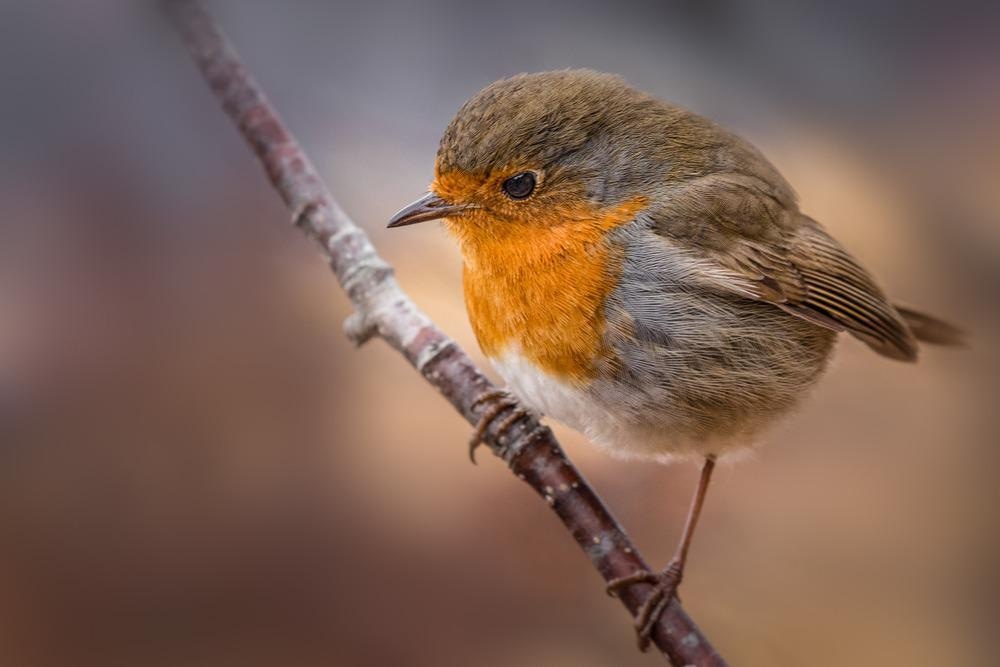Songbirds may use quantum physics to navigate long distances in the dark of night. During their annual migrations, as many birds head southwards when cold of winter sets in, this would help them know if they are heading too far north or south. Recent research suggests that quantum physics has a role to play, as electrons within a specific protein in the birds’ eyes act like little magnets due to a quantum property called spin.

Image Credit: Drakuliren/Shutterstock.com
It has long been a mystery how some birds, fish, turtles and insects can navigate the world. Migratory birds are able to travel thousands of miles between Europe and Africa each year, to rest and nest in the same place. The adversity of storms and monotonous desert landscapes do not stop them finding their destination.
Even songbirds that travel at night are able to precisely find their way. How they do this has been one of the biggest mysteries in the field of biology. Possible explanations proposed included the sensing of odors, infra-sound and gravity, though the overwhelming consensus in recent research shows that it is down to a magnetic field which can act like a map for birds.
Recent studies show that this special ability is thanks to a light-dependent magnetic compass, built into birds’ biology.
It has been shown that songbirds travelling great distances between breeding grounds and winter abodes have a magnetic compass in their eyes.
This helps them keep on track during their journey, telling them if they are going too far in one direction or the other, allowing them to make corrections.
How Does the Magnetic Compass Work?
Scientists have widely agreed that songbirds are able to navigate the magnetic field, but the reason why is more uncertain. The exact mechanism underlying this ability has long been a mystery, but recently scientists have shed more light by looking into the eye of the European robin.
As shown in a study published in Nature this year, Dr. Jingjing Xu at the University of Oldenburg in Germany and a group of international researchers analyzed proteins in the retina of a robin’s eye.
This specific protein is called cryptochrome 4 (CRY4) and is a blue light receptor considered to be the most likely sensor that can detect magnetic fields.
The group studied the reactions of these proteins under the exposure of blue laser light.
While recording how much light was absorbed, they found that the influence of a magnetic field changed how much light was absorbed.
The photochemistry of the protein was found to be magnetically sensitive, due to the ability to form pairs of highly chemically reactive ‘radicals’.
The team concluded that magnetically sensitive chemical reactions were triggered by light in the retina of the European robin, before asking the question – why?
Delving into Quantum Biology
On a deeper level, the scientists explain this process by looking to the quantum world. Within the cryptochrome proteins of the birds’ retinas, quantum spin dynamics of radical pairs took place when blue light was shone in the eye.

Image Credit: Jan Stria/Shutterstock.com
Essentially, due to the quantum property of spin, the two unpaired electrons in the protein acted like little magnets. The magnetic sensing abilities of the CRY4 protein seems to be triggered when blue light interacts with the protein, unleashing reactions around an electron, generating two unpaired electrons within the protein.
The protein can be altered as these electrons can be placed in parallel alignment or in opposite orientations.
According to quantum physics, the electrons will not stay in one position or the other, but instead will be in an in-between state named quantum superposition. The probability of the electrons staying in one position or the other is influenced by the magnetic field.
It is postulated that birds could gauge their orientation based on how much of the altered protein is created.
There is still much more to understand in this area, since it is a mystery how the bird can actually sense this. However, the study has still been a significant leap forward in being the first to experimentally confirm the long-suspected link between cryptochrome proteins and the inbuilt navigational compasses of birds.
What About Birds That Do Not Migrate?
The same test was done on other birds, in chickens and pigeons, where the introduction of the magnetic field showed little change.
The authors of the study stated: “we show that the photochemistry of cryptochrome 4 from the night-migratory European robin is magnetically sensitive, and more so than CRY4 from two non-migratory bird species, chicken and pigeon. Site-specific mutations of ErCRY4 reveal the roles of four successive flavin–tryptophan radical pairs in generating magnetic field effects.”
There was a greater reaction in the migratory bird, indicating that this may be a unique navigational tool for birds that migrate, such as the robin.
This does not mean that other birds cannot sense magnetic fields, but there has been greater sensitivity in the robin, which could have served as an evolutionary advantage.
Even for non-migratory birds, this is the first study to empirically show that the CRY4 protein is magnetically sensitive in songbirds. However, there remains more to discover about what is happening within the protein CRY4 and the deeper role that quantum mechanics plays.
References and Further Reading
Science News. (2021). A proposed ‘quantum compass’ for songbirds just got more plausible. [Online]. Available at: https://www.sciencenews.org/article/quantum-mechanics-compass-songbird-physics
DownToEarth. (2021). Birds use massive magnetic maps to migrate — and some could cover the whole world [Online]. Available at:
https://www.downtoearth.org.in/blog/wildlife-biodiversity/birds-use-massive-magnetic-maps-to-migrate-and-some-could-cover-the-whole-world-75530?fbclid=IwAR1OKqbKzRQ1KnTmqc5D8ulyGOyJcuq73b6T3nxePaQMjXSDqQLjF-nNdh8
Nikita Chernetsov, Alexander Pakhomov, Dmitry Kobylkov, Dmitry Kishkinev, Richard A. Holland, Henrik Mouritsen (2017). Migratory Eurasian Reed Warblers Can Use Magnetic Declination to Solve the Longitude Problem. Current Biology, Volume 27, Issue 17,
2017, Pages 2647-2651.e2, ISSN 0960-9822. Available at:(https://www.sciencedirect.com/science/article/pii/S0960982217308825)
Svenja Engels, Christine Maira Hein, Nele Lefeldt, Helmut Prior, Henrik Mouritsen (2012). Night-Migratory Songbirds Possess a Magnetic Compass in Both Eyes. Available at: https://doi.org/10.1371/journal.pone.0043271
Wu, H., Scholten, A., Einwich, A. et al (2020). Protein-protein interaction of the putative magnetoreceptor cryptochrome 4 expressed in the avian retina. Sci Rep 10, 7364 (2020). Available at:https://www.nature.com/articles/s41598-020-64429-y#:~:text=The%20blue%20light%20receptor%20cryptochrome,Cry4%20in%20the%20avian%20retina.
Xu, J., Jarocha, L.E., Zollitsch, T. et al. (2021). Magnetic sensitivity of cryptochrome 4 from a migratory songbird. Nature 594, 535–540 (2021). Available at: https://doi.org/10.1038/s41586-021-03618-9
Disclaimer: The views expressed here are those of the author expressed in their private capacity and do not necessarily represent the views of AZoM.com Limited T/A AZoNetwork the owner and operator of this website. This disclaimer forms part of the Terms and conditions of use of this website.